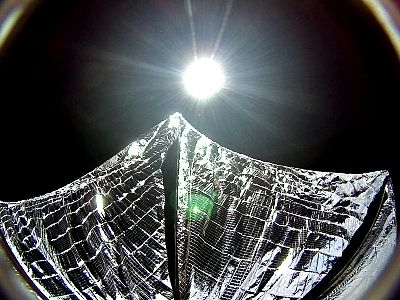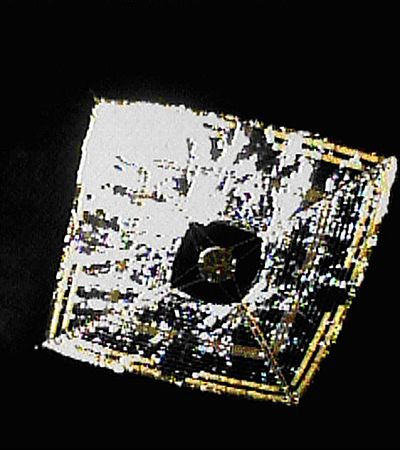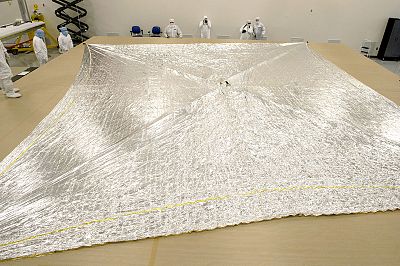These solar sails could herald a new era of spaceflight in which spacecraft forgo the rocket motors they've relied on for decades.
On June 22, a SpaceX Falcon Heavy will thunder off the launch pad at Florida's Kennedy Space Center. It's a colossal rocket — 230 feet tall, more than 3 million pounds — but the launch is a big deal mainly because of a tiny spacecraft it will carry: a bread-loaf-sized device designed to propel itself by gossamer sails that capture the pressure of sunlight.
The craft, dubbed LightSail 2, could be a prelude to a new era of spaceflight in which spacecraft forgo the rocket motors they've relied on for decades and simply sail on sunshine.
After seven days in space, LightSail 2 will pop out of its container, extend four long booms, and deploy four sheets of mirror-like Mylar plastic into a 340-square-foot, square sail. Then comes the truly magical part.
Sunlight falling on those sails will exert a tiny force, no greater than the weight of a paperclip resting on the palm of your hand. On Earth, the force of sunlight is so slight that it's unnoticeable, which is why most of us have no idea it even exists. In space, with no air to compete with, light pressure acts as a gentle but persistent wind, strong enough to move a spacecraft.
"This will be the first time navigating by light in Earth orbit," says Bill Nye, CEO of The Planetary Society, the Pasadena-based nonprofit organization that developed and funded LightSail 2. "We hope to increase the orbital energy or altitude, and change the inclination of the orbit by tacking the spacecraft like a sailboat."
From there, the possibilities are nearly limitless. With a solar sail, a spacecraft could keep going to the moon, to asteroids, to Jupiter — to anywhere the wind of light blows, using no fuel at all.
It's not easy to catch a solar breeze
LightSail 2 is the 21st century realization of an old desire to tack through space the way mariners navigate the seas. Four centuries ago, the German astronomer Johannes Kepler noticed that the tails of comets always point away from the sun — and had an inspiration. "Provide ships or sails adapted to the heavenly breezes, and there will be some who will brave even that void," he wrote to Galileo in 1608.
In the 1970s, a NASA engineer named Lou Freedman became convinced that solar sailing was actually a feasible technology. When he co-founded The Planetary Society in 1980, that idea became embedded in the group's mission. But figuring out how to build an enormous, ultralightweight sail and get it into space on an affordable budget proved a stubborn challenge.
Cosmos-1, the society's first attempt, launched in 2005 but was lost after the rocket carrying it aloft failed 82 seconds into flight. A scaled-down successor, LightSail 1, successfully deployed its sail in 2015. But it was just a technology demonstrator placed in a low orbit, where the drag from Earth's upper atmosphere overwhelmed the delicate push from the sun.
Other would-be space sailors have quietly made their own attempts, with similarly mixed results.
A 2015 test mission called CubeSail, built by the Surrey Space Centre in the U.K., failed to deploy properly, the Centre's director, Guglielmo Aglietti, told NBC News MACH in an email. Over the past decade, three other small sail missions — NASA's NanoSail-D, Canada's CanX-7 and Surrey's InflateSail — did work. But like LightSail 1, they operated close to Earth, where their sails acted like drag chutes rather than majestic celestial riggings.
Once more, into the wind
By far the greatest triumph in solar sailing so far has come from Japan's IKAROS (Interplanetary Kite-craft Accelerated by Radiation Of the Sun), launched into orbit around the sun in 2010. Once in deep space, the craft spun open a 46-foot-wide square sail and, for the first time in history, began steering and changing its speed by harnessing sunshine.
"It was one of the most moving moments in my life," Yuichi Tsuda of the Japan Aerospace Exploration Agency (JAXA) told MACH in an email.
Over the next three years, IKAROS measured the acceleration due to light pressure and tested ways to control its motion using liquid crystals in the sail (similar to an LCD electronic display) that could make it more or less reflective.
"We fulfilled all our goals perfectly," Tsuda said, reporting that the craft had been able to adjust both its course and its orientation by navigating into the wind of sunshine. Contact with IKAROS ended as expected in 2015, he added, but the spacecraft continues to loop around the sun between Earth and Venus, "its orbital shape changing and changing due to the light pressure."
In parallel with those successes, though, IKAROS revealed how much work remains to be done to realize the full potential of light propulsion. Its sail was not nearly big enough for serious swooping through the solar system, taking a full year on average to boost or reduce its speed by one half of 1 percent. IKAROS was therefore designed as a hybrid, augmenting light pressure with more conventional thrusters powered by electricity-generating solar cells built into the sail.
Sailing goes mainstream
LightSail 2 is intended to help resolve the technical problems and turn light sails into a reliable, low-cost, zero-propellant way of getting around in space. Nye takes inspiration from test pilot Tex Johnston, who in 1955 proved the flightworthiness of Boeing's 707 prototype by doing a crazy midflight roll in front of the press corps. "He supposedly told the press, 'One test is worth a thousand expert opinions.' That's why we're flying this," Nye says.
Space
A team at CU Aerospace, a private company affiliated with the University of Illinois at Urbana-Champaign, has embraced the same daredevil spirit. Last December they launched a pair of satellites called CubeSail (unrelated to the British experiment of the same name) into Earth orbit. When they reach their target location in mid-2020, the two will separate and unspool an 800-foot-long ribbon between them — a totally new kind of solar sail.
NASA is in the game, too, with a solar-sailing mission called Near Earth Asteroid Scout. It will fly aboard the agency's long-delayed Space Launch System rocket "whenever it launches," says mission principal investigator Les Johnson of NASA's Marshall Space Flight Center in Huntsville, Alabama. That could happen right around the time of the CubeSail test run.
The plan for NEA Scout is to one-up IKAROS by using the sail to reach a specific target and perform a detailed reconnaissance for the first time. "Our technology goal is to demonstrate the ability of a solar sail to propel and navigate a spacecraft through space," Johnson says. "Our science goal is to take photos of and characterize a near-earth asteroid."
Space trucking
If these missions succeed as expected, light sailing could finally begin to take off. The limited pressure of sunshine means sail-powered craft will take a long time to reach their targets, but by dispensing with fuel, they could be very simple and cheap. The budget for LightSail 2, for instance, is $7 million, a tiny fraction of a typical NASA mission. And since sunshine never runs out, light sails can keep going pretty much forever. "All you need is patience. Once you are in orbit, you're driving," Nye said.
With that in mind, JAXA has plans in the works for an IKAROS successor called OKEANOS, which would sail its way out to a group of mysterious asteroids near Jupiter. Fleets of low-cost solar sails are another possibility. David Carroll, president of CU Aerospace, says CubeSail was conceived as a first step toward UltraSail, an enormous four-winged sailing craft that the company has been designing for years.
"The beauty of the UltraSail concept is the ability to tack the sails, allowing you to travel all over the solar system back and forth as desired without requiring any sort of refueling," Carroll says. It could mark a transition from sailboat to tugboat, creating an interplanetary cargo network powered by nothing more than the relentless shining of the sun.
Want more stories about space?
- New Hubble Space Telescope photo is a 'living history book' of our universe
- Scientists finally solve the mystery of weird aurora-like lights in the sky
- The moon is shrinking, and a new study shows it's racked by moonquakes
SIGN UP FOR THE MACH NEWSLETTER AND FOLLOW NBC NEWS MACH ON TWITTER, FACEBOOK, AND INSTAGRAM.














